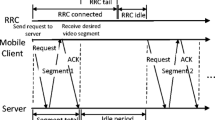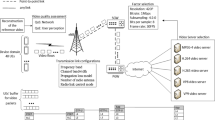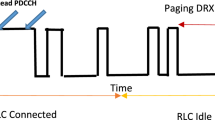Abstract
This paper proposes a novel scheduling based intelligent video streaming for device-to-device communication in wireless networks with the consideration of time-varying system. The interference in the proposed network model is changing parameter based on time. In this network, the proposed method provides a combined power control and quality of service (QoS) with a novel methodology. The main challenge in the video streaming is time scale different of power optimization and QoS. In this paper, the considered system model is a distributed multi-user wireless network having the interference, and it has the property of time variance. The work proposed confesses power optimization or power control and quality of service in a joint manner. Therefore special attention is provided in the resource allocation. This work addressed this problem and performed these two on the same time scale using the cluster based FlashlinQ scheduling. Matlab simulations illustrate the performance of this system and are discussed in the result section.










Similar content being viewed by others
References
Jingyu, Z., Gan, F., Minyi, G., Chunyi, P. (2016). How video streaming consumes power in 4G LTE networks. In World of wireless, mobile and multimedia networks, 21-24 June 2016 (vol. 1, pp. 1–3). https://doi.org/10.1109/WoWMoM.2016.7523528
Negin, G., Andreas, F. M., Alexandros, G. D., & Giuseppe, C. (2013). Femto caching and device-to-device collaboration, A new architecture for wireless video distribution. IEEE International Journal, 51(4), 142–149.
Chang-Kuan, L., Hao-Wei, C., Shiann-Chang, Y., Meng-Ting, L., Yao, J., & Chen, H. (2006). Robust video streaming over power lines. IEEE International Journal on Power Line Communications and its Applications, 1, 196–201.
Jiyan, W., Chau, Y., Ngai-Man, C., Junliang, C., & Chang, W. C. (2017). Streaming mobile cloud gaming video over TCP with adaptive source-FEC coding. IEEE Transactions on Circuits and Systems for Video Technology, 1, 32–48.
Jiyan, W., Chau, Y., Ngai-Man, C., & Junliang, C. (2016). Delay-constrained high definition video transmission in heterogeneous wireless networks with multi-homed terminals. IEEE Transactions on Mobile Computing, 15(3), 641–655.
Yung-Chih, C., Don, T., & Ramin, K. (2016). MSPlayer: Multi-source and multi-path video streaming. IEEE Journal on Selected Areas in Communications, 34(8), 2198–2206.
Wei, W., & Avideh, Z. (2009). Interference aware multipath selection for video streaming in wireless ad hoc networks. IEEE Transactions on Circuits and Systems for Video Technology, 19(2), 78–165.
Singh, S., Andrews, J. G., & de Veciana, G. (2012). Interference shaping for improved quality of experience for real-time video streaming. IEEE Journal on Selected Areas in Communications, 30(7), 1259–1269.
Liang, Z., Xinbing, W., Wei, T., Gabriel-miro, M., Benoit, G. L., Wang, X., et al. (2010). Distributed scheduling scheme for video streaming over multi-channel multi-radio multi-hop wireless networks. IEEE Journal on Selected Areas in Communications, 28, 3.
Wei, Y., Taesoo, K., & Changyong, S. (2013). Multicell coordination via joint scheduling, beam forming, and power spectrum adaptation. IEEE Transactions on Wireless Communications, 12(7), 1–4.
Han-Shin, J., Cheol, M., June, M., & Jong-Gwan, Y. (2009). Interference mitigation using uplink power control for two-tier femtocell networks. IEEE Transactions on Wireless Communications, 8, 10.
Jianwei, H., Zhu, L., Mung, C., & Aggelos, K. K. (2008). Joint source adaptation and resource allocation for multi-user wireless video streaming. IEEE Transactions on Circuits and Systems for Video Technology, 18(5), 582–595.
Zhihai, H., Yongfang, L., Lulin, C., Ahmad, I., & Dapeng, W. (2005). Power-rate-distortion analysis for wireless video communication under energy constraints. IEEE Transactions on Circuits and Systems for Video Technology, 15(5), 645–658.
Qian, Z., Wenwu, Z., & Ya-qin, Z. (2005). End-to-end QoS for video delivery over wireless Internet. Proceedings of the IEEE, 93(1), 123–134.
Dapeng, W., Hou, Y. T., Wenwu, Z., Ya-Qin, Z., & Peha, J. M. (2001). Streaming video over the internet: Approaches and directions. IEEE Transactions on Circuits and Systems for Video Technology, 11(3), 282–300.
Curt, S., Vijay, R., & Mani, B. S. (2003). Power management for energy-aware communication systems. ACM Transactions on Embedded Computing Systems (TECS), 2(3), 47–431.
Shiao-Li, T., & You-Lin, C. (2008). Energy-efficient packet scheduling algorithms for real-time communications in a mobile WiMAX system. Computer Communications, 31(10), 9–2350.
Guan-Ming, S., Xiao, S., Yan, B., Mea, W., Athanasios, V. V., & Haohong, W. (2016). QoE in video streaming over wireless networks: Perspectives and research challenges. Wireless Networks, 22(5), 1571–1593.
Qi, J., Victor, C. M. L., Mahsa, T. P., Hao, T., & Hong-Sheng, X. (2016). Energy-efficient adaptive transmission of scalable video streaming in cognitive radio communications. IEEE Systems Journal, 10(2), 761–772.
Jie, T., Haixia, Z., Dalei, W., & Dongfeng, Y. (2016). Interference-aware cross-layer design for distributed video transmission in wireless networks. IEEE Transactions on Circuits and Systems for Video Technology, 26(5), 978–991.
Yang, C., Tao, J., Xu, C., & Junshan, Z. (2016). Social-aware video multicast based on device-to-device communications. IEEE Transactions on Mobile Computing, 15(6), 39–1528.
Jun-Pyo, H., & Wan, C. (2016). User prefix caching for average playback delay reduction in wireless video streaming. IEEE Transactions on Wireless Communications, 15(1), 88–377.
Joongheon, K., Giuseppe, C., & Andreas, F. M. (2016). Quality-aware streaming and scheduling for device-to-device video delivery”. IEEE/ACM Transactions on Networking, 24(4), 2319–2331.
Ayaz, A., Naveed, U. H., Mohamad, A., & Hamidou, T. (2016). Joint power control and rate adaptation for video streaming in wireless networks with time-varying interference. IEEE Transactions on Vehicular Technology, 65(8), 6315–6329.
Liang, Q., Zhengxue, C., Zheng, F., Lianghui, D., Feng, Y., & Wei, H. (2017). A QoE-driven encoder adaptation scheme for multi-user video streaming in wireless networks. IEEE Transactions on Broadcasting, 63(1), 20–31.
Shigang, C., & Nahrstedt, K. (1999). Distributed quality-of-service routing in ad hoc networks. IEEE Journal on Selected Areas in Communications, 17(8), 1488–1505.
Patwari, N., Hero, A. O., Perkins, M., Correal, N. S., & O’Dea, R. J. (2003). Relative location estimation in wireless sensor networks. IEEE Transactions on Signal Processing, 51(8), 2137–2148.
Srie, V. J. E., & Ganesh, K. P. (2015). Energy efficient cluster based scheduling scheme for wireless sensor networks. The Scientific World Journal. https://doi.org/10.1155/2015/185198.
Younis, O., & Fahmy, S. (2004). HEED: A hybrid, energy-efficient, distributed clustering approach for ad hoc sensor networks. IEEE Transactions on Mobile Computing, 3(4), 366–379.
Xinzhou, W., Saurabha, T., & Sanjay, S. (2013). FlashLinQ: A synchronous distributed scheduler for peer-to-peer ad hoc networks. IEEE/ACM Transactions on Networking (TON), 21(4), 1215–1228.
Honghai, Z., Yanyan, Z., Mohammad, A. K., & Sampath, R. (2010). Cross-layer optimization for streaming scalable video over fading wireless networks. IEEE Journal on Selected Areas in Communications, 28, 3.
Author information
Authors and Affiliations
Corresponding author
Additional information
Publisher's Note
Springer Nature remains neutral with regard to jurisdictional claims in published maps and institutional affiliations.
Rights and permissions
About this article
Cite this article
Prakash, P.B., Vijila, C.K.S. Novel Scheduling Based Intelligent Video Streaming for Device-to-Device Communication in Wireless Networks. Wireless Pers Commun 104, 617–631 (2019). https://doi.org/10.1007/s11277-018-6037-2
Published:
Issue Date:
DOI: https://doi.org/10.1007/s11277-018-6037-2




